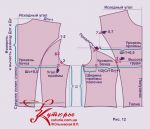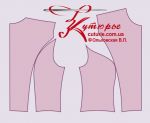Vera Olkhovskaya
The pattern has reached the greatest popularity in mass tailoring. embossed base (or tuck) from the armhole, as it is suitable for all kinds of shapes and sizes, even remotely suitable for the definition of "medium".
There are many differences in the proposed framework. Pay attention to how the increase should be distributed in this case ...
 So, the distribution of the increase in free fit is unusual: to the width of the front and back - according to 0,5-0,7 cm, the rest - to expand the armhole. The armhole in this bodice based on the relief of the armhole should be as high as possible, and the length of the shoulder can be reduced by 1 см. All these nuances must be taken into account if you want to achieve a high degree of fit. The increase in the chest in this case should not exceed 4 см.
So, the distribution of the increase in free fit is unusual: to the width of the front and back - according to 0,5-0,7 cm, the rest - to expand the armhole. The armhole in this bodice based on the relief of the armhole should be as high as possible, and the length of the shoulder can be reduced by 1 см. All these nuances must be taken into account if you want to achieve a high degree of fit. The increase in the chest in this case should not exceed 4 см.
Back (Fig. 12). Step back from the horizontal cut of the paper down 2 см and draw horizontal lines parallel to it: the original, armholes, waist. Construct a sprout (see the description of the construction of a sprout and a shoulder in the previous basics). The shoulder cut does not have a tuck, so for the base you need a serif with a length Dp.
Note 7. The tuck, which provides a fit in the area of the shoulder blades, in this basis is located in the relief from the armhole.
Barrel level - from the waist up, set aside Db.
According to the level of the barrel from the middle line of the back, set aside
ws + 0,5 cm
and build from the resulting point perpendicular to the level of the armhole with a length 7 - 8 cm. The bisector of the angle of the armhole is 3 cm, and the solution of the tuck from the armhole 1 - 2 cm.
The side slope of the back is
1/4 (Sg - St) minus 0,5 cm
The barrel is drawn with a concave line and lengthened down by 0,3-0,5 cm.
Solution of thallium tuck:
side bevel + 1 cm
Decorate the relief, armhole and waist section with arbitrarily smooth lines, as in the previous basics. Adjust the lengths of the relief lines.
Shelves. Start with the waist and barrel levels - just extend the horizontal lines of the same name on the back. Measure from the waist up dpt and take the original, from the original down measurement Wg - the level of the chest, and again from the original down - the level of the armhole.
To determine the height of the armhole of the shelf in this basis, as in the previous one, it is necessary to measure, according to the drawing of the back, the distance from the midpoint of the sprout to the level of the height of the barrel (measured along the midline). From the obtained value, subtract the tabular value, which corresponds to the difference between the measurements Ds и dpt.
Further results should be deferred in the direction from the vertical half-skid to the side cut. Build the neckline and shoulder cut.
Neck: set aside along the original horizontal
1/3Ssh + 0,5cm,
vertically -
(1/3Ssh + 0,5 cm) + 1 cm
and connect the resulting points with a smooth line.
At the intersection of two arcs drawn from the lateral point of the neck with a radius Dp and from the point of convexity of the chest with a radius npp, mark the shoulder point and connect it to the already existing point at the intersection of the baseline with the side point of the neck.
small chest width
Shg1 + 0,5 cm
set aside at the level of the armhole. From the resulting point, set aside 4 -7 cm. After that, you can build a section of the armhole from the shoulder point to the relief. To do this, from point "7" to the line of half-skid, retreat to 0,7 см. And, extending the length of the chest height towards the side seam by 1,5 - 2 cm, smoothly connect the points "0,7" and "2", and then extend the line to the waist.
shelf width
1/2(Sg + Pg) + 1 cm
set aside according to the height of the barrel.
Having an extreme side point, you can determine the width of the armhole of the shelf. From the armhole width common to the front and back, which is equal to 1/4Cr, subtract the width of the back armhole, and set aside the difference from the highest point of the barrel. The perpendicular to the armhole is equal to the perpendicular that limits the width of the chest - from 4-x to 7 см. Both of these segments are shown in the drawing by dotted lines. In our example earlier, to limit the width of the chest, a segment with a length of 7 см, therefore, for the angle of the armhole, we must also take a segment equal to 7 cm.
Bevel of the side seam of the shelf:
back bevel minus 0,5 cm
Waist tuck solution 3,5 - 4 cm. To check: the sum of the lengths of the segments along the waist of the shelf and back should be equal to
st + 2cm
When designing relief lines, it is important that they are of the same length. Usually, the relief cut of the part of the “barrels of the shelf” turns out to be shorter than necessary, so it is lengthened, extending towards the armhole. The missing lines must be drawn smoothly.


 Join my community on Viber...
Join my community on Viber...











